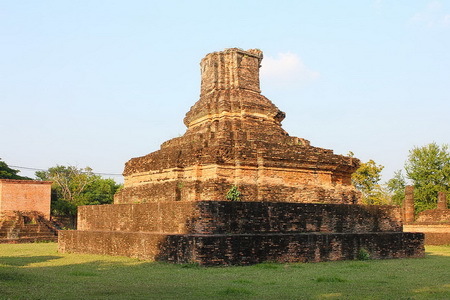

Unknown & lesser visited temples of Sukhothai Historical ParkMost of the big impressive temples have already been covered in my guide to Sukhothai Historical Park. They are all really worth visiting as obligatory – must sees. But what of the others that you’ll walk by on the way? Those large brick chedi’s, broken wats and in some cases chunks of stone scattered around a field, are they worth visiting? Let’s take a look at the other side of Sukhothai and the ruins that you might be passing like everyone else but should really stop and discover. Wat Sra Sri & Tra Pang Tra KuaPerhaps the best known of the lesser known wats in Sukhothai this complex containing a massive Chedi.  In front of the Chedi is an assembly hall where only the columns that once supported the roof now remain. Ta Pha Daeng ShrineLocated to the north of Sukhothai historical park this laterite shrine was built in Khmer style. High chambers look out from the west and eastern sides with the easter side being longer.  During excavation work here statues of various Hindu gods and goddesses were found adorned with gems. The shrine is believed to be from the early 12th century. Wat Chana SongkhramThere is a huge bell shaped Chedi here that towers over an assembly hall similar to many others found in Sukhothai. What’s really interesting is that in front of the assembly hall is an unusual smaller chedi.  This much smaller ornate chedi is similar to others in Si Satchanalai (another historic park near Sukhothai). Such distinctive markings place it firmly in the Ayutthaya period. Wat Chedi Yod HakThis wat is actually outside of Sukhothai Historical Park’s official grounds. It’s located on the east of the park along the main road to Sukhothai city to the left. Alongside the wat ruins are several local houses. If you are driving by you might even miss it!  Wat Chedi Yod Yak is no more than over 24 stone columns in various states of collapse that once supported a roof. Behind them is a large brick temple in an equal state of ruin. What’s nice here is that this wat shows how valued it still is. Children from the local neighbourhood play amongst the ancient ruins with glee. There is no vandalisim here. No graffiti and people still place Buddha statues here. Wat on KhaoThis small temple is largely in ruins and little is known about it. Wat on Khao is located near the north gate and Wat Sorasak. There is a small assembly hall here in ruins.  Wat on Khao is best known for its lotus like chedi appearance. As there was no name for the temple found during excavations Wat on Khao was named by local residence in 1965. Wat SorasakThis temple is famed for the elephant statues that run around it’s base. Elephants in Sukhothai were once seen as beasts of burden for the emperor.  According to an inscription found at the temple, Wat Sorask was built prior to the 14th century. It was built by Nai Intha Sorasak who was granted the land by the emperor to build a temple dedicated to him. Wat Tao Thu RiangYes, some wat’s are no more than just bricks. This is the case of Wat Tao Thu Riang.  Still today locals adorn it with more modern Buddha statues. Wat Tra KuanThis temple is said to be from the 15th century. Wat Tra Kuam means Phak Bung or Morning Glory which is a vegetable.  There is a chedi and an ordination hall still standing here but like most the hall has no roof. There are however some early buddha images located around the area. Monument of King Ramkhamhaeng the GreatFinally there is a statue of the third king of Sukhothai King Ramkhamhaeng the Great. He is credited for creating the modern Thai alphabet.  The statue was opened in 1969. It is made from bronze and copper. Nearby is an ancient stone pillar and a toll bell worth checking out. Today people still come here to give thanks. Planning on booking a hotel room in Sukhothai? Here are the best online rates guaranteed! I recommend you try my own hotel search for Sukhothai |

